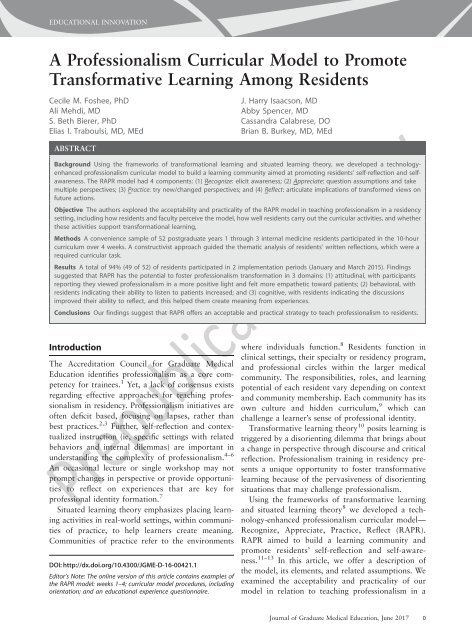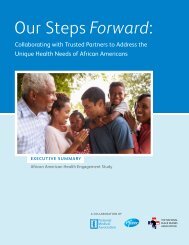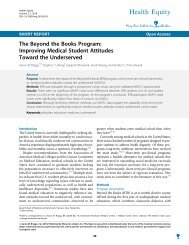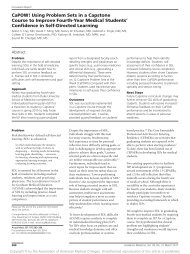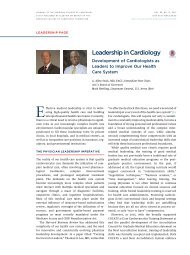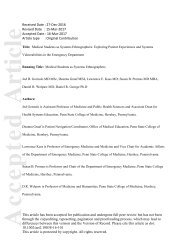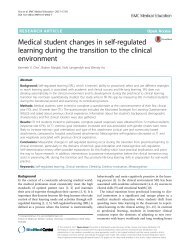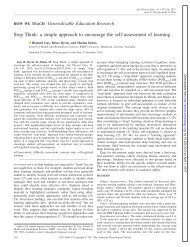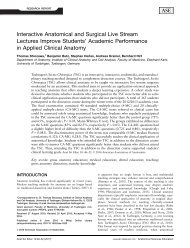Promoting Self-Reflection in Medical Residency
You also want an ePaper? Increase the reach of your titles
YUMPU automatically turns print PDFs into web optimized ePapers that Google loves.
EDUCATIONAL INNOVATION<br />
A Professionalism Curricular Model to Promote<br />
Transformative Learn<strong>in</strong>g Among Residents<br />
Cecile M. Foshee, PhD<br />
Ali Mehdi, MD<br />
S. Beth Bierer, PhD<br />
Elias I. Traboulsi, MD, MEd<br />
ABSTRACT<br />
J. Harry Isaacson, MD<br />
Abby Spencer, MD<br />
Cassandra Calabrese, DO<br />
Brian B. Burkey, MD, MEd<br />
Background Us<strong>in</strong>g the frameworks of transformational learn<strong>in</strong>g and situated learn<strong>in</strong>g theory, we developed a technologyenhanced<br />
professionalism curricular model to build a learn<strong>in</strong>g community aimed at promot<strong>in</strong>g residents’ self-reflection and selfawareness.<br />
The RAPR model had 4 components: (1) Recognize: elicit awareness; (2) Appreciate: question assumptions and take<br />
multiple perspectives; (3) Practice: try new/changed perspectives; and (4) Reflect: articulate implications of transformed views on<br />
future actions.<br />
Objective The authors explored the acceptability and practicality of the RAPR model <strong>in</strong> teach<strong>in</strong>g professionalism <strong>in</strong> a residency<br />
sett<strong>in</strong>g, <strong>in</strong>clud<strong>in</strong>g how residents and faculty perceive the model, how well residents carry out the curricular activities, and whether<br />
these activities support transformational learn<strong>in</strong>g,<br />
Methods A convenience sample of 52 postgraduate years 1 through 3 <strong>in</strong>ternal medic<strong>in</strong>e residents participated <strong>in</strong> the 10-hour<br />
curriculum over 4 weeks. A constructivist approach guided the thematic analysis of residents’ written reflections, which were a<br />
required curricular task.<br />
Results A total of 94% (49 of 52) of residents participated <strong>in</strong> 2 implementation periods (January and March 2015). F<strong>in</strong>d<strong>in</strong>gs<br />
suggested that RAPR has the potential to foster professionalism transformation <strong>in</strong> 3 doma<strong>in</strong>s: (1) attitud<strong>in</strong>al, with participants<br />
report<strong>in</strong>g they viewed professionalism <strong>in</strong> a more positive light and felt more empathetic toward patients; (2) behavioral, with<br />
residents <strong>in</strong>dicat<strong>in</strong>g their ability to listen to patients <strong>in</strong>creased; and (3) cognitive, with residents <strong>in</strong>dicat<strong>in</strong>g the discussions<br />
improved their ability to reflect, and this helped them create mean<strong>in</strong>g from experiences.<br />
Conclusions Our f<strong>in</strong>d<strong>in</strong>gs suggest that RAPR offers an acceptable and practical strategy to teach professionalism to residents.<br />
Introduction<br />
The Accreditation Council for Graduate <strong>Medical</strong><br />
Education identifies professionalism as a core competency<br />
for tra<strong>in</strong>ees. 1 Yet, a lack of consensus exists<br />
regard<strong>in</strong>g effective approaches for teach<strong>in</strong>g professionalism<br />
<strong>in</strong> residency. Professionalism <strong>in</strong>itiatives are<br />
often deficit based, focus<strong>in</strong>g on lapses, rather than<br />
best practices. 2,3 Further, self-reflection and contextualized<br />
<strong>in</strong>struction (ie, specific sett<strong>in</strong>gs with related<br />
behaviors and <strong>in</strong>ternal dilemmas) are important <strong>in</strong><br />
understand<strong>in</strong>g the complexity of professionalism. 4–6<br />
An occasional lecture or s<strong>in</strong>gle workshop may not<br />
prompt changes <strong>in</strong> perspective or provide opportunities<br />
to reflect on experiences that are key for<br />
professional identity formation. 7<br />
Situated learn<strong>in</strong>g theory emphasizes plac<strong>in</strong>g learn<strong>in</strong>g<br />
activities <strong>in</strong> real-world sett<strong>in</strong>gs, with<strong>in</strong> communities<br />
of practice, to help learners create mean<strong>in</strong>g.<br />
Communities of practice refer to the environments<br />
DOI: http://dx.doi.org/10.4300/JGME-D-16-00421.1<br />
Editor’s Note: The onl<strong>in</strong>e version of this article conta<strong>in</strong>s examples of<br />
the RAPR model: weeks 1–4; curricular model procedures, <strong>in</strong>clud<strong>in</strong>g<br />
orientation; and an educational experience questionnaire.<br />
where <strong>in</strong>dividuals function. 8 Residents function <strong>in</strong><br />
cl<strong>in</strong>ical sett<strong>in</strong>gs, their specialty or residency program,<br />
and professional circles with<strong>in</strong> the larger medical<br />
community. The responsibilities, roles, and learn<strong>in</strong>g<br />
potential of each resident vary depend<strong>in</strong>g on context<br />
and community membership. Each community has its<br />
own culture and hidden curriculum, 9 which can<br />
challenge a learner’s sense of professional identity.<br />
Transformative learn<strong>in</strong>g theory 10 posits learn<strong>in</strong>g is<br />
triggered by a disorient<strong>in</strong>g dilemma that br<strong>in</strong>gs about<br />
a change <strong>in</strong> perspective through discourse and critical<br />
reflection. Professionalism tra<strong>in</strong><strong>in</strong>g <strong>in</strong> residency presents<br />
a unique opportunity to foster transformative<br />
learn<strong>in</strong>g because of the pervasiveness of disorient<strong>in</strong>g<br />
situations that may challenge professionalism.<br />
Us<strong>in</strong>g the frameworks of transformative learn<strong>in</strong>g<br />
and situated learn<strong>in</strong>g theory 8 we developed a technology-enhanced<br />
professionalism curricular model—<br />
Recognize, Appreciate, Practice, Reflect (RAPR).<br />
RAPR aimed to build a learn<strong>in</strong>g community and<br />
promote residents’ self-reflection and self-awareness.<br />
11–13 In this article, we offer a description of<br />
the model, its elements, and related assumptions. We<br />
exam<strong>in</strong>ed the acceptability and practicality of our<br />
model <strong>in</strong> relation to teach<strong>in</strong>g professionalism <strong>in</strong> a<br />
Journal of Graduate <strong>Medical</strong> Education, June 2017 0
EDUCATIONAL INNOVATION<br />
graduate medical education sett<strong>in</strong>g. For acceptability,<br />
we explored the perceptions of residents and faculty<br />
regard<strong>in</strong>g the RAPR model. For practicality, we<br />
evaluated whether residents can perform curricular<br />
activities to support transformative learn<strong>in</strong>g.<br />
Methods<br />
Participants<br />
We purposefully selected 52 of 168 <strong>in</strong>ternal medic<strong>in</strong>e<br />
residents (postgraduate years 1–3 [PGY-1 to PGY-3])<br />
at a large Midwestern academic medical center to<br />
participate <strong>in</strong> a 10-hour, 4-week professionalism<br />
curriculum. Residents were selected based on their<br />
availability dur<strong>in</strong>g the planned implementation period<br />
of January and March 2015 (Mondays, 7 AM). The<br />
program director notified the 52 eligible residents of<br />
their assignment to the RAPR curriculum and asked<br />
them to attend the sessions as part of their standard<br />
academic obligations. Residents were expected to<br />
attend; however, they were not penalized for schedule<br />
conflicts. Our implementation procedures are outl<strong>in</strong>ed<br />
<strong>in</strong> the onl<strong>in</strong>e supplemental material.<br />
Curriculum<br />
A committee of educators and cl<strong>in</strong>icians designed and<br />
implemented a technology-enhanced professionalism<br />
curricular model compris<strong>in</strong>g 4 units: Recognize,<br />
Appreciate, Practice, Reflect (provided as onl<strong>in</strong>e<br />
supplemental <strong>in</strong>formation). Each week of the curriculum<br />
was dedicated to a unit: (1) Recognize<br />
(<strong>in</strong>creased awareness of professional exemplars); (2)<br />
Appreciate (fostered a professionalism knowledge<br />
base); (3) Practice (targeted application); and (4)<br />
Reflect (prompted reflection about <strong>in</strong>sights and<br />
implications).<br />
The implementation of RAPR was technology<br />
facilitated through annotated videos, key articles,<br />
and relevant materials. Technology also enhanced<br />
faculty’s ability to provide feedback through tools and<br />
immediate access to residents’ reflections, comments,<br />
and concerns. We developed a web portal (http://<br />
www.cmfoshee.com/ccf-community) and organized<br />
content around RAPR us<strong>in</strong>g collaborative technologies<br />
(wiki, blogs, social media) 14 to support the<br />
curriculum and the transformative learn<strong>in</strong>g tenets.<br />
The Cleveland Cl<strong>in</strong>ic’s Institutional Review Board<br />
designated the protocol for this curriculum as exempt.<br />
Data and Analysis<br />
To explore the acceptability and practicality of the<br />
model, we tracked attendance and completion of<br />
onl<strong>in</strong>e activities <strong>in</strong> relation to required tasks. Upon<br />
conclusion of each 4-week curricular block, we<br />
What was known and gap<br />
Professionalism often is taught <strong>in</strong> s<strong>in</strong>gle lectures, and little is<br />
known about acceptability and practicality of a larger<br />
professionalism curriculum.<br />
What is new<br />
A 4-week professionalism curriculum with specified tasks,<br />
<strong>in</strong>clud<strong>in</strong>g reflection, and award of a certification at completion.<br />
Limitations<br />
Small sample, s<strong>in</strong>gle <strong>in</strong>stitution, and s<strong>in</strong>gle specialty study<br />
reduce generalizability.<br />
Bottom l<strong>in</strong>e<br />
Face-to-face of professionalism was the most successful<br />
aspect of the <strong>in</strong>tervention; provid<strong>in</strong>g protected time for<br />
learners to explore professionalism is key to effective<br />
learn<strong>in</strong>g.<br />
adm<strong>in</strong>istered a 15-item Educational Experience Questionnaire<br />
(EEQ) to assess outcomes for each curricular<br />
activity (eg, ‘‘Reflect<strong>in</strong>g helped me clarify my<br />
understand<strong>in</strong>g about professionalism’’), provided as<br />
onl<strong>in</strong>e supplemental material. We conducted 2 focus<br />
groups with a total of 10 volunteer residents to<br />
determ<strong>in</strong>e whether focus group participants voiced<br />
different reactions than those evidenced <strong>in</strong> the written<br />
reflections or questionnaire responses, and to improve<br />
the experience of the second cohort based on <strong>in</strong>put<br />
from the first. After complet<strong>in</strong>g both 4-week blocks,<br />
we conducted faculty <strong>in</strong>terviews (with 6 of 10 faculty<br />
who taught the curriculum) to elicit their perspectives<br />
on the curricular model and the practicality of the<br />
approach.<br />
To evaluate the extent to which RAPR supports<br />
transformative learn<strong>in</strong>g of professionalism, we collected<br />
written reflections from the 4 required tasks:<br />
def<strong>in</strong>itions, collaborative vision, critical reflections,<br />
and lessons learned. Adopt<strong>in</strong>g a constructivist paradigm,<br />
15 1 author (C.M.F.) conducted a thematic<br />
analysis 16 and tagged comments related to the<br />
transformative theory perspective (self-awareness/<br />
changed perspectives, views, or attitudes), followed<br />
by repeated exam<strong>in</strong>ation to <strong>in</strong>fer prevalent patterns.<br />
Another author (S.B.B.) <strong>in</strong>dependently reviewed this<br />
analysis. Both authors explored the data to reach<br />
consensus on overarch<strong>in</strong>g themes. A similar approach<br />
was used to code focus groups and faculty <strong>in</strong>terviews.<br />
These data served to support/refute patterns and<br />
themes <strong>in</strong>ferred from the analysis of residents’ written<br />
reflections.<br />
Because our approach aimed to <strong>in</strong>crease selfawareness<br />
and reflection, and encourage perspective<br />
tak<strong>in</strong>g and positivity, we anticipated that empathy<br />
and resilience would be relevant by-products of the<br />
curriculum. 17 We adm<strong>in</strong>istered the Jefferson Scale of<br />
Physician Empathy 18 and the Resilience Scale 19 on 3<br />
0 Journal of Graduate <strong>Medical</strong> Education, June 2017
EDUCATIONAL INNOVATION<br />
different occasions: the start of the curriculum (T1),<br />
midway (T2, after first 4-week block), and upon<br />
completion of both blocks (T3). We conducted a<br />
repeated-measures analysis of variance, with empathy<br />
and resilience as dependent variables and time as the<br />
<strong>in</strong>dependent variable. Residents received their <strong>in</strong>dividual<br />
scores along with their cohort’s average score<br />
as tools for self-reflection.<br />
We anticipated that this curricular experience<br />
would enhance professional <strong>in</strong>teractions; therefore,<br />
we awarded Professionalism Quality Improvement<br />
certificates commensurate to their level of engagement.<br />
Results<br />
A total of 52 residents met the <strong>in</strong>clusion criteria, and<br />
49 (94%) participated. Prior to start of the curriculum,<br />
3 residents dropped out due to schedul<strong>in</strong>g<br />
conflicts. Those available <strong>in</strong> January (24) comprised<br />
the first cohort, and those available <strong>in</strong> March (25)<br />
comprised the second cohort. The majority of<br />
participat<strong>in</strong>g residents were male (33 of 49; 67%),<br />
younger than 30 years (43 of 49; 88%), and equally<br />
distributed among PGY-1 through PGY-3 (PGY-1, 17<br />
[35%]; PGY-2, 16 [33%]; and PGY-3, 16 [33%]).<br />
There were no statistically significant differences<br />
between means across the factor of time (T1, T2,<br />
T3) for either empathy or resilience.<br />
Acceptability<br />
A majority of the residents who completed the EEQ<br />
(87%; 34 of 39) agreed they would participate <strong>in</strong> the<br />
program aga<strong>in</strong> (TABLE). Focus group data and faculty<br />
<strong>in</strong>terviews augmented the sense of acceptance by<br />
describ<strong>in</strong>g the experience as a ‘‘much-needed forum to<br />
discuss issues’’ not addressed elsewhere <strong>in</strong> residency<br />
curricula. The technology utilization/acceptance was<br />
not as anticipated: residents shared m<strong>in</strong>imal reflections<br />
us<strong>in</strong>g social media, and focus group data<br />
confirmed that residents disliked us<strong>in</strong>g social media<br />
to share reflections. Nonetheless, a small majority<br />
agreed that the portal <strong>in</strong>creased engagement. Technology<br />
enabled the onl<strong>in</strong>e submissions of required<br />
tasks: def<strong>in</strong>itions, critical reflections, and lessons<br />
learned.<br />
We observed higher acceptance/compliance <strong>in</strong> the<br />
second cohort, which may be due to changes<br />
implemented, based on feedback from the first cohort<br />
focus group. Changes <strong>in</strong>cluded extended orientation,<br />
weekly rem<strong>in</strong>ders, pr<strong>in</strong>ted to-do lists distributed at<br />
each session, <strong>in</strong>-session time to work on ‘‘shared<br />
vision,’’ and elect<strong>in</strong>g a volunteer from each small<br />
group to submit the group’s f<strong>in</strong>al vision.<br />
Practicality<br />
Successful completion of required tasks (TABLE) and<br />
award<strong>in</strong>g of 45 certificates (92%) confirmed the<br />
practicality of the curricular activities. Certificates<br />
were awarded at attendance (8 of 49; 16%),<br />
participation (18 of 49; 37%), and achievement (19<br />
of 49; 39%) levels to recognize residents’ efforts<br />
toward improv<strong>in</strong>g professional <strong>in</strong>teractions. While<br />
focus groups and faculty <strong>in</strong>terviews highlighted that<br />
residents found it challeng<strong>in</strong>g to f<strong>in</strong>d the time to<br />
engage with the curriculum dur<strong>in</strong>g busy rotations,<br />
faculty and residents agreed that the activities were<br />
worthwhile and manageable.<br />
The thematic analysis of residents’ reflections (82<br />
reflections, 314 codes) suggested that the curriculum<br />
fostered professionalism transformations <strong>in</strong> 3 general<br />
doma<strong>in</strong>s: attitud<strong>in</strong>al, behavioral, and cognitive, with<br />
the EEQ responses echo<strong>in</strong>g the themes <strong>in</strong> the analysis<br />
(TABLE).<br />
Attitud<strong>in</strong>al Doma<strong>in</strong>: Attitud<strong>in</strong>al doma<strong>in</strong> related to<br />
reflections about a change of view, attitude, or<br />
perspective. Consistent with the goal of the activities<br />
<strong>in</strong> ‘‘Recognize’’—to enhance awareness—residents reported<br />
view<strong>in</strong>g professionalism <strong>in</strong> a more positive light.<br />
‘‘I used to [view] professionalism tra<strong>in</strong><strong>in</strong>g as a<br />
punishment. ... Prior to these sessions, I didn’t<br />
recognize that my tra<strong>in</strong><strong>in</strong>g needed to <strong>in</strong>clude<br />
professionalism. ...’’<br />
‘‘Reflect<strong>in</strong>g made me th<strong>in</strong>k and notice professional<br />
behavior <strong>in</strong> me and others and f<strong>in</strong>d out which traits<br />
I should carry <strong>in</strong> me.’’<br />
Behavioral Doma<strong>in</strong>: Behavioral doma<strong>in</strong> denoted<br />
explicit reflections about hav<strong>in</strong>g modified, adopted, or<br />
stopped specific behaviors. Residents’ comments supported<br />
the ‘‘Appreciate’’ aim of build<strong>in</strong>g a cognitive base<br />
with statements that alluded to <strong>in</strong>creased empathy and<br />
deeper understand<strong>in</strong>g.<br />
‘‘Now I am cont<strong>in</strong>ually rem<strong>in</strong>d<strong>in</strong>g myself to engage<br />
patients and deploy true and real empathy.’’<br />
‘‘This program had a positive implication <strong>in</strong> my<br />
<strong>in</strong>teractions with the patients.’’<br />
‘‘This program allowed me to understand and<br />
<strong>in</strong>ternalize my own def<strong>in</strong>ition of professionalism<br />
and therefore make it part of my activities.’’<br />
Cognitive Doma<strong>in</strong>: Cognitive doma<strong>in</strong> reflections<br />
comprised residents’ <strong>in</strong>terpretations/mean<strong>in</strong>g of pro-<br />
Journal of Graduate <strong>Medical</strong> Education, June 2017 0
EDUCATIONAL INNOVATION<br />
TABLE<br />
Educational Experience Questionnaire (EEQ) Responses a<br />
Question No. (%)<br />
Response rate 39/49 (80)<br />
Would you participate aga<strong>in</strong>?<br />
Yes 34/39 (87)<br />
No 5/39 (13)<br />
Agreed and strongly agreed rat<strong>in</strong>gs<br />
relat<strong>in</strong>g to curricular activities<br />
Observations <strong>in</strong>creased situational 34/39 (87)<br />
awareness<br />
<strong>Reflection</strong> enhanced understand<strong>in</strong>g 34/39 (87)<br />
of professionalism<br />
<strong>Reflection</strong> helped create mean<strong>in</strong>g 33/39 (85)<br />
Def<strong>in</strong><strong>in</strong>g professionalism <strong>in</strong>creased 31/39 (79)<br />
understand<strong>in</strong>g<br />
Def<strong>in</strong><strong>in</strong>g professionalism <strong>in</strong>fluenced 29/39 (74)<br />
behavior change<br />
<strong>Self</strong>-monitor<strong>in</strong>g helped identify<br />
28/39 (72)<br />
behavior patterns<br />
Collaboration helped build<br />
30/39 (77)<br />
relationships<br />
Shar<strong>in</strong>g own experiences enhanced 32/39 (82)<br />
self-awareness<br />
Group discussions helped ga<strong>in</strong> new 33/39 (85)<br />
perspectives<br />
Overall experienced changed view of 30/39 (77)<br />
professionalism<br />
Agreed and strongly agreed rat<strong>in</strong>gs relat<strong>in</strong>g to technology<br />
Web portal <strong>in</strong>creased engagement 23/39 (59)<br />
Videos <strong>in</strong>creased view<strong>in</strong>g of<br />
20/39 (51)<br />
<strong>in</strong>formation<br />
Social media <strong>in</strong>creased reflections 16/39 (41)<br />
Wiki <strong>in</strong>creased discussion<br />
13/39 (33)<br />
contributions<br />
Curricular activities: proportion of<br />
completed tasks across curriculum<br />
Face-to-face sessions<br />
Attendance: Monday morn<strong>in</strong>gs 49/49 (100)<br />
Onl<strong>in</strong>e activities<br />
Def<strong>in</strong>itions: due week 2 29/49 (59)<br />
Critical reflections: due week 3 25/49 (51)<br />
Lessons learned: due week 4 26/49 (53)<br />
Surveys<br />
Jefferson Empathy Scale: all 3 19/49 b (39)<br />
times<br />
Resilience Scale: all 3 times 21/49 b (43)<br />
EEQ: adm<strong>in</strong>istered once 39/49 (80)<br />
a A 15-item, 7-po<strong>in</strong>t Likert-style scale with the anchors strongly disagree<br />
(1) and strongly agree (7).<br />
b Value <strong>in</strong>dicates number of surveys completed across all adm<strong>in</strong>istrations<br />
of each survey; does not account for surveys completed only once or<br />
twice.<br />
fessionalism. This doma<strong>in</strong> exhibited features of<br />
‘‘Practice’’ and ‘‘Reflect’’ with its focus on creat<strong>in</strong>g<br />
mean<strong>in</strong>g and reflect<strong>in</strong>g. Residents viewed the reflections,<br />
discussions, and process of def<strong>in</strong><strong>in</strong>g professionalism<br />
as activities that helped them shape their<br />
th<strong>in</strong>k<strong>in</strong>g and behavior.<br />
‘‘The sem<strong>in</strong>ar has broadened my perspective of<br />
professionalism ... has helped me work toward<br />
develop<strong>in</strong>g a deeper understand<strong>in</strong>g of behaviors.’’<br />
‘‘I will start chang<strong>in</strong>g the way I approach difficult<br />
situations by outl<strong>in</strong><strong>in</strong>g the th<strong>in</strong>gs I hope to<br />
accomplish <strong>in</strong>stead of the th<strong>in</strong>gs I want to avoid.’’<br />
Discussion<br />
Our approach ga<strong>in</strong>ed acceptance from residents and<br />
faculty, who reported they would participate <strong>in</strong> the<br />
program aga<strong>in</strong>. Residents expressed awareness and<br />
perspective shifts <strong>in</strong>dicative of transformational<br />
learn<strong>in</strong>g. Although our <strong>in</strong>tervention did not enhance<br />
residents’ empathy or resilience, our study identified a<br />
facilitative role for technology <strong>in</strong> facilitat<strong>in</strong>g task<br />
completion, and potentially self-reflection.<br />
The grounded theory data offer 1 strategy to<br />
engender self-reflection about professionalism that<br />
aligns with best practices <strong>in</strong> the literature. 2 In contrast<br />
to the typical lectures or 1-time sem<strong>in</strong>ars, our 4-week<br />
approach placed emphasis on foster<strong>in</strong>g self-awareness,<br />
develop<strong>in</strong>g strengths, explor<strong>in</strong>g relationships<br />
between values and behavior, and creat<strong>in</strong>g mean<strong>in</strong>gful<br />
experiences through critical discourse. RAPR presents<br />
educators with an <strong>in</strong>tervention to deepen the teach<strong>in</strong>g<br />
of professionalism with needed framework to address<br />
professionalism and its related ethical dilemmas. 20<br />
The lack of impact of the curriculum on residents’<br />
empathy and resilience is <strong>in</strong>consistent with the<br />
literature. 21–23 It is likely that sample size and poor<br />
completion rates across time contributed to the<br />
nonsignificant changes, as only a m<strong>in</strong>ority of residents<br />
completed all 3 assessments. It also is possible that the<br />
length of exposure to the curriculum was too brief, or<br />
the measures used were not sufficiently sensitive to<br />
detect changes.<br />
Our expectation that residents would share professionalism-related<br />
thoughts/feel<strong>in</strong>gs us<strong>in</strong>g social media<br />
was not met. Residents rejected this public forum,<br />
likely because it does not provide for the safe<br />
environment required for self-disclosure/candor related<br />
to professionalism. Also, social media activity did<br />
not capture residents’ reactions to content shared. For<br />
example, through focus groups, we learned that 1<br />
video (TED: ‘‘Doctors Make Mistakes. Can We Talk<br />
0 Journal of Graduate <strong>Medical</strong> Education, June 2017
EDUCATIONAL INNOVATION<br />
About That?’’) was so powerful that residents<br />
engaged <strong>in</strong> hallway conversations—yet, they rema<strong>in</strong>ed<br />
silent on social media.<br />
The assessment of this <strong>in</strong>tervention has limitations,<br />
reduc<strong>in</strong>g the generalizability of our f<strong>in</strong>d<strong>in</strong>gs. Aspects<br />
<strong>in</strong>clude the reliance on self-reports and the modest<br />
sample size from a s<strong>in</strong>gle specialty at 1 <strong>in</strong>stitution.<br />
Both faculty and learners viewed time as a major<br />
barrier to future replication.<br />
Based on our experience, we recommend mak<strong>in</strong>g<br />
the curriculum part of academic half-days; protect<strong>in</strong>g<br />
faculty time; tra<strong>in</strong><strong>in</strong>g chief residents to provide<br />
feedback; remov<strong>in</strong>g social media; utiliz<strong>in</strong>g exist<strong>in</strong>g<br />
tools (eg, Moodle or other learn<strong>in</strong>g management<br />
systems); <strong>in</strong>clud<strong>in</strong>g exist<strong>in</strong>g professionalism rat<strong>in</strong>gs;<br />
and consider<strong>in</strong>g us<strong>in</strong>g a transformational learn<strong>in</strong>g<br />
<strong>in</strong>strument. 24 To evaluate the impact of the curriculum<br />
on professional behavior, future implementations<br />
should consider deliver<strong>in</strong>g RAPR over 8 to 12 weeks<br />
<strong>in</strong> a face-to-face format enhanced by the onl<strong>in</strong>e<br />
reflection activities.<br />
Conclusion<br />
Our f<strong>in</strong>d<strong>in</strong>gs support the use of RAPR as a<br />
promis<strong>in</strong>g model to cultivate self-reflection and<br />
deeper understand<strong>in</strong>g about professionalism. We<br />
found RAPR to be an acceptable and practical<br />
approach to teach<strong>in</strong>g professionalism <strong>in</strong> graduate<br />
medical education. The face-to-face sessions were<br />
the most successful aspect of the <strong>in</strong>tervention.<br />
Provid<strong>in</strong>g for protected time to explore professionalism<br />
<strong>in</strong> mean<strong>in</strong>gful ways is key to a transformative<br />
learn<strong>in</strong>g approach.<br />
References<br />
1. Accreditation Council for Graduate <strong>Medical</strong> Education.<br />
CLER pathways to excellence. 2013;29:1–38. https://<br />
www.acgme.org/Portals/0/PDFs/CLER/CLER_Brochure.<br />
pdf. Accessed March 29, 2017.<br />
2. Byyny RL, Papadakis MA, Paauw DS, eds. <strong>Medical</strong><br />
Professionalism: Best Practices. Menlo Park, CA: Alpha<br />
Omega Alpha Honor <strong>Medical</strong> Society; 2015. http://<br />
alphaomegaalpha.org/pdfs/2015<strong>Medical</strong>Professionalism.<br />
pdf. Accessed March 29, 2017.<br />
3. May N, Becker D, Frankel R, et al. Appreciative Inquiry<br />
<strong>in</strong> Healthcare: Positive Questions to Br<strong>in</strong>g Out the<br />
Best. Brunswick, OH: Crown Custom Publish<strong>in</strong>g Inc;<br />
2011.<br />
4. Project Professionalism. Philadelphia, PA: American<br />
Board of Internal Medic<strong>in</strong>e; 1994. https://<br />
medic<strong>in</strong>a<strong>in</strong>ternaucv.files.wordpress.com/2013/02/<br />
project-professionalism.pdf. Accessed March 29, 2017.<br />
5. Cruess RL, Cruess SR, Johnston SE. Renew<strong>in</strong>g<br />
professionalism: an opportunity for medic<strong>in</strong>e. Acad<br />
Med. 1999;74(8):878–884.<br />
6. Lucey C, Souba W. Perspective: the problem with the<br />
problem of professionalism. Acad Med.<br />
2010;85(6):1018–1024.<br />
7. Wald HS. Professional identity (trans)formation <strong>in</strong><br />
medical education: reflection, relationship, resilience.<br />
Acad Med. 2015;90(6):701–706.<br />
8. Lave J. Situat<strong>in</strong>g learn<strong>in</strong>g <strong>in</strong> communities of practice.<br />
In: Resnick LB, Lev<strong>in</strong>e JM, Teasley SD, eds.<br />
Perspectives of Socially Shared Cognition. Wash<strong>in</strong>gton,<br />
DC: American Psychological Association; 1991:63–82.<br />
http://www1.udel.edu/educ/whitson/files/Lave,%20<br />
Situat<strong>in</strong>g%20learn<strong>in</strong>g%20<strong>in</strong>%20communities%20<br />
of%20practice.pdf. Accessed March 29, 2017.<br />
9. Rogers DA, Boehler ML, Roberts NK, et al. Us<strong>in</strong>g the<br />
hidden curriculum to teach professionalism dur<strong>in</strong>g the<br />
surgery clerkship. J Surg Educ. 2012;69(3):423–427.<br />
10. Mezirow J. Transformative learn<strong>in</strong>g: theory to practice.<br />
New Dir Adult Cont<strong>in</strong> Educ. 1997;74:5–12.<br />
11. Yardkey S, Teunissen PW, Dornan T. Experiential<br />
learn<strong>in</strong>g: AMEE Guide No. 63. Med Teach.<br />
2012;34(2):e102–e115.<br />
12. Schutz S. <strong>Reflection</strong> and reflective practice. Commun<br />
Pract. 2017;80(9):26–29.<br />
13. Branch WT Jr. The road to professionalism: reflective<br />
practice and reflective learn<strong>in</strong>g. Patient Educ Couns.<br />
2010;80(3):327–332.<br />
14. Jo<strong>in</strong>t Information Systems Committee. Effective<br />
practice <strong>in</strong> a digital age: a guide to technology-enhanced<br />
learn<strong>in</strong>g and teach<strong>in</strong>g. 2009. http://usir.salford.ac.uk/<br />
2796/2/effectivepracticedigitalage.pdf. Accessed March<br />
29, 2017.<br />
15. Teherani A, Martimianakis T, Stenfors-Hayes T, et al.<br />
Choos<strong>in</strong>g a qualitative research approach. J Grad Med<br />
Educ. 2015;17(4):669–670.<br />
16. Braun V, Clarke V. Us<strong>in</strong>g thematic analysis <strong>in</strong><br />
psychology. Quant Res Psychol. 2006;3(2):77–101.<br />
17. Epste<strong>in</strong> RM, Krasner MS. Physician resilience: what it<br />
means, why it matters, and how to promote it. Acad<br />
Med. 2013;88(3):301–303.<br />
18. Hojat M, Gonella JS, Maxwell K. Jefferson Scales of<br />
Empathy: Professional Manual and User Guide.<br />
Philadelphia, PA: Thomas Jefferson University; 2009.<br />
19. Wagnild GM. The Resilience Scale User’s Guide.<br />
Version 3.33. Resilience Center. 2014.<br />
20. Kesselheim JC, Sectish T, Joffe S. Education <strong>in</strong><br />
professionalism: results from a survey of pediatric<br />
residency program directors. J Grad Med Educ.<br />
2012;4(1):101–105.<br />
21. Stepien KA, Baernste<strong>in</strong> A. Educat<strong>in</strong>g for empathy: a<br />
review. J Gen Intern Med. 2006;21(5):524–530.<br />
Journal of Graduate <strong>Medical</strong> Education, June 2017 0
EDUCATIONAL INNOVATION<br />
22. Duke P, Grosseman S, Novack DH, et al. Preserv<strong>in</strong>g<br />
third year medical students’ empathy and enhanc<strong>in</strong>g<br />
self-reflection us<strong>in</strong>g small group ‘‘virtual hangout’’<br />
technology. Med Teach. 2015;37(6):566–571.<br />
23. Jackson D, Firtko A, Edenborough M. Personal<br />
resilience as a strategy for surviv<strong>in</strong>g and thriv<strong>in</strong>g <strong>in</strong> the<br />
face of workplace adversity: a literature review. J Adv<br />
Nurs. 2007;60(1):1–9.<br />
24. Caruana V, Woodrow K, Pérez L. Us<strong>in</strong>g the learn<strong>in</strong>g<br />
activities survey to exam<strong>in</strong>e transformative learn<strong>in</strong>g<br />
experiences <strong>in</strong> two graduate teacher preparation<br />
courses. InSight. 2015;10:25–34. http://files.eric.ed.<br />
gov/fulltext/EJ1074047.pdf. Accessed March 29, 2017.<br />
Cecile M. Foshee, PhD, is Director of Graduate <strong>Medical</strong><br />
Education Curriculum Development, Education Institute,<br />
Cleveland Cl<strong>in</strong>ic; Ali Mehdi, MD, is Academic Hospitalist and<br />
Cl<strong>in</strong>ical Instructor, Medic<strong>in</strong>e Institute, Cleveland Cl<strong>in</strong>ic; S. Beth<br />
Bierer, PhD, is Director of Evaluation and Associate Professor,<br />
Cleveland Cl<strong>in</strong>ic Lerner College of Medic<strong>in</strong>e; Elias I. Traboulsi,<br />
MD, MEd, is Director of Graduate <strong>Medical</strong> Education, Education<br />
Institute, Cleveland Cl<strong>in</strong>ic; J. Harry Isaacson, MD, is Assistant<br />
Dean for Cl<strong>in</strong>ical Education and Associate Professor, Cleveland<br />
Cl<strong>in</strong>ic Lerner College of Medic<strong>in</strong>e; Abby Spencer, MD, is Director,<br />
Internal Medic<strong>in</strong>e <strong>Residency</strong> Program, and Vice Chair of<br />
Education, Medic<strong>in</strong>e Institute, Cleveland Cl<strong>in</strong>ic; Cassandra<br />
Calabrese, DO, is a Fellow, Rheumatology and Infectious Disease,<br />
Medic<strong>in</strong>e Institute, Cleveland Cl<strong>in</strong>ic; and Brian B. Burkey, MD,<br />
MEd, is <strong>Medical</strong> Director, Center for Consumer Health<br />
Information, and Vice-Chairman, Head and Neck Institute,<br />
Cleveland Cl<strong>in</strong>ic.<br />
Fund<strong>in</strong>g: The authors report no external fund<strong>in</strong>g source for this<br />
study.<br />
Conflict of <strong>in</strong>terest: The authors declare they have no compet<strong>in</strong>g<br />
<strong>in</strong>terests.<br />
Portions of this work were previously exhibited as an oral<br />
presentation at the Society of General Internal Medic<strong>in</strong>e Midwest<br />
Regional Meet<strong>in</strong>g, Cleveland, Ohio, August 27–28, 2015; as a<br />
roundtable discussion at the American Educational Research<br />
Association Annual Meet<strong>in</strong>g, Wash<strong>in</strong>gton, DC, April 8–12, 2016;<br />
and as a workshop at the Association of Program Directors <strong>in</strong><br />
Internal Medic<strong>in</strong>e Spr<strong>in</strong>g Conference, Las Vegas, Nevada, April<br />
17–20, 2016.<br />
The authors would like to thanks Drs Leonard Calabrese, Janet<br />
Buccola, Lakshmi Khatri, and Carmen Paradis for their dedication<br />
and profound contribution to this work. The authors would also<br />
like to thank Drs Colleen Colbert and Judith French for their<br />
valuable <strong>in</strong>put. Additionally, the authors acknowledge that this<br />
curriculum is consistent with the current approaches used <strong>in</strong> the<br />
Cleveland Cl<strong>in</strong>ic Internal Medic<strong>in</strong>e <strong>Residency</strong> Foundations of<br />
Resident Assessment, Mentor<strong>in</strong>g, and Emotional Intelligence<br />
(FRAME) program led by Drs Frank Michota and Jennifer Ramsey,<br />
among others.<br />
Correspond<strong>in</strong>g author: Cecile M. Foshee, PhD, Cleveland Cl<strong>in</strong>ic,<br />
NA24, 9500 Euclid Avenue, Cleveland, OH 44195, 216.444.0455,<br />
fosheec@ccf.org<br />
Received July 11, 2016 revisions received November 7, 2016 and<br />
December 27, 2017; accepted January 4, 2017.<br />
0 Journal of Graduate <strong>Medical</strong> Education, June 2017


